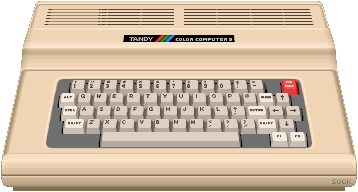
7/22/2023 9:45 PM: -- I owned a CoCo3 back in the day!
I bought it in 1988 after being in Brazil for 4 years. I bought it brand new, w/ a CM-8 monitor, an FD-502 floppy controller, along w/ OS-9 Level II. At some point not long after that I bought a 720k 3.5 floopy drive and added it as the second floppy drive. I also bought a couple of OS-9 books. One was the Complete Rainbow Guide to Os-9 Level II Paperback, I can't remember the other.
The CoCo3 is quite a powerful 8bit computer. It uses the Motorola MC6809 CPU which has 16bit features and re-entrant, re-locatable subroutines so that true pre-emptive multitasking is possible. It came with 128k stock and was expandable to 512K officially through Tandy. Memory could be paged in out of the 64k address space using 8k blocks of ram. 3rd party companies came out w/ the ability to expand RAM to 2 Megs.
The combination of the 6809 and the MMU allowed the CoCo3 to run a powerful OS called OS-9. Which was a real-time multi-user, multi-tasking OS. That was quite advanced for an 8bit computer. During that timeframe DOS was the mainstay for businesses and could only accomplish one task at a time out of the box.
The advanced hardware (MMU, VDG, Timers and other functions) were provided through a custom chip called the GIME. The main two things missing from the GIME were dedicated hardware sound capability and the ability to do hardware assisted graphics such as tiling, sprites and/or a blitter. It does have the abililty to do hardware scrolling to a certain degree.
Instead we have linear bitmap graphic modes for the video and a 6bit DAC for sound. The CPU had to manage the sound and graphics in code in addition to the program or game logic code.
Later it was found out that the Hitachi 6309, a 6809 compatible CPU, had a native mode that included more registers, more powerful instructions, and a 32bit accumulator and it could run at faster clock rates even though none of the CoCo's could run faster than 1.79 MHz which was double the standard 0.895 MHz.
If the CoCo3 had the hardware sound and video that was perhaps slightly more advanced than say a Commodore 64 or Atari 800 it would have been quite powerful indeed, giving the Amiga a run for it's money in bang-for-the-buck comparison for the time.